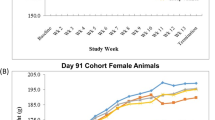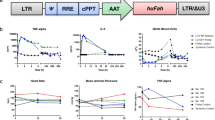Abstract
The progression of chronic renal diseases is considered as an irreversible process that eventually leads to end-stage renal failure characterized by extensive tissue fibrosis. At present, chronic renal fibrosis is incurable and the incidence of affected patients is on the rise worldwide. In this study, we demonstrate that delivery of hepatocyte growth factor (HGF) gene via systemic administration of naked plasmid vector markedly ameliorated renal fibrosis in an animal model of chronic renal disease induced by unilateral ureteral obstruction. A high level of exogenous HGF protein was detected in the obstructed kidneys following intravenous injection of naked plasmid encoding human HGF. Delivery of human HGF gene induced a sustained activation of extracellular signal-regulated kinases-1 and -2 in the obstructed kidneys. Exogenous HGF expression dramatically inhibited α-smooth muscle actin expression, attenuated renal interstitial accumulation and deposition of collagen I and fibronectin. In addition, exogenous HGF suppressed renal expression of pro-fibrogenic cytokine TGF-β1 and its type I receptor in vivo. These results suggest that systemic administration of naked plasmid vector introduces a high level of exogenous HGF to the diseased kidneys, and that HGF gene transfer may provide a novel therapeutic strategy for amelioration of chronic renal fibrosis in vivo. Gene Therapy (2001) 8, 1470–1479.
This is a preview of subscription content, access via your institution
Access options
Subscribe to this journal
Receive 12 print issues and online access
We are sorry, but there is no personal subscription option available for your country.
Buy this article
- Purchase on Springer Link
- Instant access to full article PDF
Prices may be subject to local taxes which are calculated during checkout







Similar content being viewed by others
References
Eddy AA . Molecular insights into renal interstitial fibrosis J Am Soc Nephrol 1996 7: 2495–2508
Remuzzi G, Bertani T . Pathophysiology of progressive nephropathies N Engl J Med 1998 339: 1448–1456
Port FK, Fenton SSA, Mazzuchi N . ESRD throughout the world: morbidity, mortality and quality of life Kidney Int 2000 57: S1–S2
Kawaida K, Matsumoto K, Shimazu H, Nakamura T . Hepatocyte growth factor prevents acute renal failure and accelerates renal regeneration in mice Proc Natl Acad Sci USA 1994 91: 4357–4361
Miller SB, Martin DR, Kissane J, Hammerman MR . Hepatocyte growth factor accelerates recovery from acute ischemic renal injury in rats Am J Physiol 1994 266: F129–F134
Hammerman MR et al. Acute renal failure. III. The role of growth factors in the process of renal regeneration and repair Am J Physiol Renal Physiol 2000 279: F3–F11
Vargas GA, Hoeflich A, Jehle PM . Hepatocyte growth factor in renal failure: promise and reality Kidney Int 2000 57: 1426–1436
Zarnegar R, Michalopoulos GK . The many faces of hepatocyte growth factor: from hepatopoiesis to hematopoiesis J Cell Biol 1995 129: 1177–1180
Matsumoto K, Nakamura T . Hepatocyte growth factor: renotropic role and potential therapeutics for renal diseases Kidney Int 2001 59: 2023–2038
Michalopoulos GK, DeFrances MC . Liver regeneration Science 1997 276: 60–66
Liu Y, Sun AM, Dworkin LD . Hepatocyte growth factor protects renal epithelial cells from apoptotic cell death Biochem Biophys Res Commun 1998 246: 821–826
Yo Y et al. Potential role of hepatocyte growth factor in the maintenance of renal structure: anti-apoptotic action of HGF on epithelial cells Kidney Int 1998 54: 1128–1138
Liu Y . Hepatocyte growth factor promotes renal epithelial cell survival by dual mechanisms Am J Physiol Renal Physiol 1999 277: F624–F633
Fornoni A et al. Hepatocyte growth factor, but not insulin-like growth factor I, protects podocytes against cyclosporin A-induced apoptosis Am J Pathol 2001 158: 275–280
Mizuno S et al. Hepatocyte growth factor prevents renal fibrosis and dysfunction in a mouse model of chronic renal disease J Clin Invest 1998 101: 1827–1834
Ueki T et al. Hepatocyte growth factor gene therapy of liver cirrhosis in rats Nat Med 1999 5: 226–230
Liu Y, Rajur K, Tolbert E, Dworkin LD . Endogenous hepatocyte growth factor ameliorates chronic renal injury by activating matrix degradation pathways Kidney Int 2000 58: 2028–2043
Mizuno S et al. Reciprocal balance of hepatocyte growth factor and transforming growth factor-b1 in renal fibrosis in mice Kidney Int 2000 57: 937–948
Liu ML, Mars WM, Zarnegar R, Michalopoulos GK . Uptake and distribution of hepatocyte growth factor in normal and regenerating adult rat liver Am J Pathol 1994 144: 129–140
Yang J et al. Sustained expression of naked plasmid DNA encoding hepatocyte growth factor in mice promotes liver and overall body growth Hepatology 2001 33: 848–859
Pearson G et al. Mitogen-activated protein (MAP) kinase pathways: regulation and physiological functions Endocr Rev 2001 22: 153–183
Chang L, Karin M . Mammalian MAP kinase signaling cascades Nature 2001 410: 37–40
Matsumoto K, Mizuno S, Nakamura T . Hepatocyte growth factor in renal regeneration, renal disease and potential therapeutics Curr Opin Nephrol Hypertens 2000 9: 395–402
Takayama H et al. Renal tubular hyperplasia, polycystic disease, and glomerulosclerosis in transgenic mice overexpressing hepatocyte growth factor/scatter factor Lab Invest 1997 77: 131- 138
Kelley VR, Suhatme VP . Gene transfer in the kidney Am J Physiol 1999 276: F1–F9
Imai E, Isaka Y . New paradigm of gene therapy: skeletal-muscle-targeting gene therapy for kidney disease Nephron 1999 83: 296–300
Liu F, Song YK, Liu D . Hydrodynamics-based transfection in animals by systemic administration of plasmid DNA Gene Therapy 1999 6: 1258–1266
Li S, Huang L . Nonviral gene therapy: promises and challenges Gene Therapy 2000 7: 31–34
He Y et al. Intravenous injection of naked DNA encoding secreted flt3 ligand dramatically increases the number of dendritic cells and natural killer cells in vivo Hum Gene Ther 2000 11: 547–554
Liu Y et al. Up-regulation of hepatocyte growth factor receptor: an amplification and targeting mechanism for hepatocyte growth factor action in acute renal failure Kidney Int 1999 55: 442–453
Lai LW, Moeckel GW, Lien YHH . Kidney-targeted liposome-mediated gene transfer in mice Gene Therapy 1997 4: 426–431
Shiota G, Wang TC, Nakamura T, Schmidt EV . Hepatocyte growth factor in transgenic mice: effects on hepatocyte growth, liver regeneration and gene expression Hepatology 1994 19: 962–972
Bell A et al. The five amino acid-deleted isoform of hepatocyte growth factor promotes carcinogenesis in transgenic mice Oncogene 1999 18: 887–895
Garcia-Ocana A et al. Hepatocyte growth factor overexpression in the islet of transgenic mice increases beta cell proliferation, enhances islet mass, and induces mild hypoglycemia J Biol Chem 2000 275: 1226–1232
Roberts IS et al. Interstitial myofibroblasts: predictors of progression in membranous nephropathy J Clin Pathol 1997 50: 123–127
Ng YY et al. Tubular epithelial-myofibroblast transdifferentiation in progressive tubulointerstitial fibrosis in 5/6 nephrectomized rats Kidney Int 1998 54: 864–876
Okada H, Danoff TM, Kalluri R, Neilson EG . Early role of Fsp1 in epithelial-mesenchymal transformation Am J Physiol 1997 273: F563–F574
Sharma K, Ziyadeh FN . The emerging role of transforming growth factor-β in kidney diseases Am J Physiol 1994 266: F829–F842
Border WA, Noble NA . Interactions of transforming growth factor-beta and angiotensin II in renal fibrosis Hypertension 1998 31: 181–188
Massague J, Blain SW, Lo RS . TGF-beta signaling in growth control, cancer and heritable disorders Cell 2000 103: 295–309
Schiffer M et al. Smad proteins and transforming growth factor-beta signaling Kidney Int 2000 58: S45–S52
Isaka Y et al. Transforming growth factor-beta1 antisense oligodeoxynucleotides block interstitial fibrosis in unilateral ureteral obstruction Kidney Int 2000 58: 1885–1892
Kretzschmar M, Doody J, Timokhina I, Massague J . A mechanism of repression of TGFβ/Smad signaling by oncogenic Ras Genes Dev 1999 13: 804–816
Chevalier RL et al. Renal tubulointerstitial injury from ureteral obstruction in the neonatal rat is attenuated by IGF-1 Kidney Int 2000 57: 882–890
Liu Y et al. Constitutive expression of HGF modulates renal epithelial cell phenotype and induces c-met and fibronectin expression Exp Cell Res 1998 242: 174–185
Acknowledgements
This work was supported by the National Institutes of Health grants DK-02611, and DK-54922 (YL). JY was supported in part by the Pathology Postdoctoral Research Training Grant from the Department of Pathology at the University of Pittsburgh School of Medicine.
Author information
Authors and Affiliations
Rights and permissions
About this article
Cite this article
Yang, J., Dai, C. & Liu, Y. Systemic administration of naked plasmid encoding hepatocyte growth factor ameliorates chronic renal fibrosis in mice. Gene Ther 8, 1470–1479 (2001). https://doi.org/10.1038/sj.gt.3301545
Received:
Accepted:
Published:
Issue Date:
DOI: https://doi.org/10.1038/sj.gt.3301545
Keywords
This article is cited by
-
Pharmacological Mobilization and Recruitment of Stem Cells in Rats Stops Abdominal Adhesions After Laparotomy
Scientific Reports (2019)
-
Opposite role of CD44-standard and CD44-variant-3 in tubular injury and development of renal fibrosis during chronic obstructive nephropathy
Kidney International (2014)
-
A microRNA-30e/mitochondrial uncoupling protein 2 axis mediates TGF-β1-induced tubular epithelial cell extracellular matrix production and kidney fibrosis
Kidney International (2013)
-
The role of EMT in renal fibrosis
Cell and Tissue Research (2012)
-
Combined Paracrine and Endocrine AAV9 mediated Expression of Hepatocyte Growth Factor for the Treatment of Renal Fibrosis
Molecular Therapy (2010)



